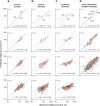This is a preprint.
Location- and feature-based selection histories make independent, qualitatively distinct contributions to urgent visuomotor performance
- PMID: 38853897
- PMCID: PMC11160778
- DOI: 10.1101/2024.05.29.596532
Location- and feature-based selection histories make independent, qualitatively distinct contributions to urgent visuomotor performance
Update in
-
Location- and feature-based selection histories make independent, qualitatively distinct contributions to urgent visuomotor performance.Elife. 2025 Jun 5;13:RP100280. doi: 10.7554/eLife.100280. Elife. 2025. PMID: 40471201 Free PMC article.
Abstract
Attention mechanisms guide visuomotor behavior by weighing physical salience and internal goals to prioritize stimuli as choices for action. Although less well studied, selection history, which reflects multiple facets of experience with recent events, is increasingly recognized as a distinct source of attentional bias. To examine how selection history impacts saccadic choices, we trained two macaque monkeys to perform an urgent version of an oddball search task in which a red target appeared among three green distracters, or vice versa. By imposing urgency, performance could be tracked continuously as it transitioned from uninformed guesses to informed choices as a function of processing time. This, in turn, permitted assessment of attentional control as manifest in motor biases, processing speed, and asymptotic accuracy. Here, we found that the probability of making a correct choice was strongly modulated by the histories of preceding target locations and target colors. Crucially, although both effects were gated by success (or reward), their dynamics were clearly distinct: whereas location history promoted a motor bias, color history modulated perceptual sensitivity, and these influences acted independently. Thus, combined selection histories can give rise to enormous swings in visuomotor performance even in simple tasks with highly discriminable stimuli.
Figures











Similar articles
-
Location- and feature-based selection histories make independent, qualitatively distinct contributions to urgent visuomotor performance.Elife. 2025 Jun 5;13:RP100280. doi: 10.7554/eLife.100280. Elife. 2025. PMID: 40471201 Free PMC article.
-
Stimulus salience conflicts and colludes with endogenous goals during urgent choices.iScience. 2023 Feb 21;26(3):106253. doi: 10.1016/j.isci.2023.106253. eCollection 2023 Mar 17. iScience. 2023. PMID: 36922998 Free PMC article.
-
Investigating the role of exogenous cueing on selection history formation.Psychon Bull Rev. 2019 Aug;26(4):1282-1288. doi: 10.3758/s13423-019-01591-z. Psychon Bull Rev. 2019. PMID: 30924059
-
Decoupling speed and accuracy in an urgent decision-making task reveals multiple contributions to their trade-off.Front Neurosci. 2014 Apr 23;8:85. doi: 10.3389/fnins.2014.00085. eCollection 2014. Front Neurosci. 2014. PMID: 24795559 Free PMC article. Review.
-
Folic acid supplementation and malaria susceptibility and severity among people taking antifolate antimalarial drugs in endemic areas.Cochrane Database Syst Rev. 2022 Feb 1;2(2022):CD014217. doi: 10.1002/14651858.CD014217. Cochrane Database Syst Rev. 2022. PMID: 36321557 Free PMC article.
References
Publication types
Grants and funding
LinkOut - more resources
Full Text Sources
